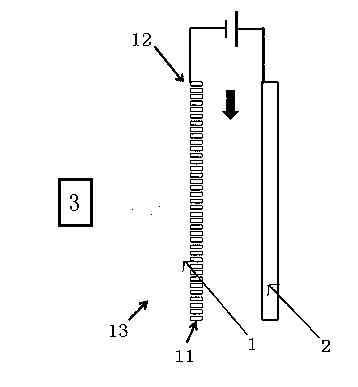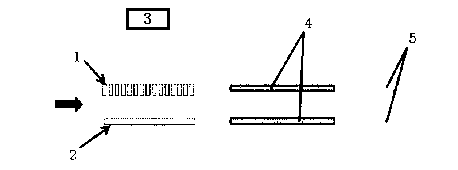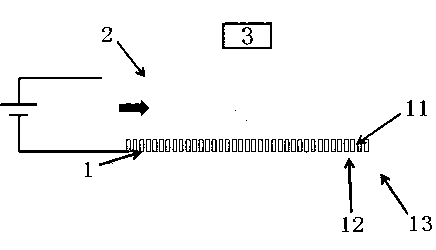Photoelectric-effect ion source based on carbon nano-tubes
A carbon nanotube and photoelectric effect technology, applied in the field of ion source, can solve the problems of inconvenient practical application, low conversion efficiency of ionization source, etc., and achieve the effects of good chemical stability, improved electron tunneling probability, and easy ionization process.
- Summary
- Abstract
- Description
- Claims
- Application Information
AI Technical Summary
Problems solved by technology
Method used
Image
Examples
Embodiment 1
[0031] The structure of the ion source based on the photoelectric effect of carbon nanotubes according to the present invention is as figure 1 As shown, it includes a power supply, and the positive pole of the power supply is connected to the counter electrode 2; the counter electrode 2 preferably adopts a grid-like electrode. The negative pole of the power supply is connected with a carbon nanotube electrode 1, the carbon nanotube electrode 1 includes a carbon nanotube layer 11 and a substrate 12, and the carbon nanotube layer 11 in the carbon nanotube electrode 1 is single-walled carbon nanotube. The carbon nanotube layer 11 is arranged on the inner side of the substrate 12 and it is opposite to the counter electrode 2. The carbon nanotube layer in this embodiment is 300 nanometers, and between the carbon nanotube layer 11 and the counter electrode 2 There is a channel for the sample to pass through in the middle. The ultraviolet emitting device 3 irradiates the carbon nan...
Embodiment 2
[0035] Another embodiment of the ion source based on the photoelectric effect of carbon nanotubes according to the present invention is figure 2 As shown, in this embodiment, the ultraviolet emitting device 3 is arranged behind the carbon nanotube electrode 1, and the ultraviolet rays can be irradiated on the substrate 12 by backlighting, since the substrate 12 is made of a transparent material such as Quartz glass sheet is used to ensure that effective ultraviolet rays can pass through smoothly. The ultraviolet rays pass through the substrate 12 to irradiate the carbon nanotube layer 11, and the thickness of the carbon nanotube layer 11 is 10-200 nanometers so that the ultraviolet rays can pass through.
Embodiment 3
[0037] The ion source based on the photoelectric effect of carbon nanotubes of the present invention, on the basis of the above embodiment 1, is provided with a temperature-controllable heating device 13 on the outside of the substrate 12, and the temperature-controllable heating device 13 Preferably, a temperature-controllable heating plate is used; the temperature-controllable heating device 13 heats the carbon nanotubes when they undergo the photoelectric effect, so as to help electrons overcome the potential barrier of work function and further improve the quantum coefficient of photoemission.
PUM
 Login to View More
Login to View More Abstract
Description
Claims
Application Information
 Login to View More
Login to View More - R&D
- Intellectual Property
- Life Sciences
- Materials
- Tech Scout
- Unparalleled Data Quality
- Higher Quality Content
- 60% Fewer Hallucinations
Browse by: Latest US Patents, China's latest patents, Technical Efficacy Thesaurus, Application Domain, Technology Topic, Popular Technical Reports.
© 2025 PatSnap. All rights reserved.Legal|Privacy policy|Modern Slavery Act Transparency Statement|Sitemap|About US| Contact US: help@patsnap.com



